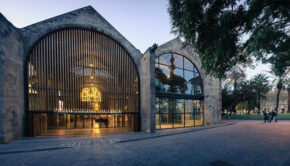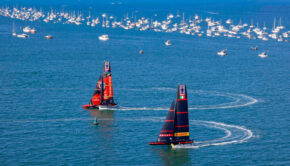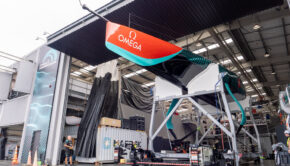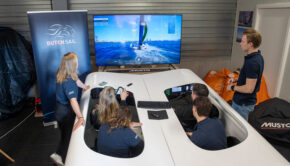America’s Cup: Sentiments from the Southern Hemisphere
Published on March 25th, 2017
It would be hard to imagine the America’s Cup without New Zealand. Since their first foray in 1987, their excellence on the water and banter off the course makes the event more interesting. Their media like to take swings too, as displayed in this report by Paul Lewis of the New Zealand Herald:
Whatever this regatta to be held in Bermuda is, it doesn’t feel much like the America’s Cup.
Where’s the bitchiness? Where’s the rivalry, the international jousting? Where, for Pete’s sake, is any kind of colour or interest? Where the hell is Bermuda?
The latest reworking of the rules to suit Oracle Team USA and its cosy little band of challengers underlines the point. OTUSA have so comprehensively de-knackered the challengers, they seem barely worthy of the name so far.
Things will liven up a bit when the racing starts – though the latest, retrospective changes allowing challengers (and Oracle) to test their boats together before racing may also reduce the anticipation and mystery of the first days of the regatta, when eager eyes strain to identify the fastest boat.
These days the America’s Cup, once a fascinating zoo of antipathy and rivalry, is a chummy cabal of OTUSA and challengers Land Rover BAR (skippered by Sir Ben Ainslie), Artemis, Softbank Team Japan and Groupama Team France – toy poodles dancing on their hind legs when Oracle command.
Emirates Team New Zealand sit quietly off to one side, like the disgraced handbag dog who crapped in the handbag. Has there ever been an America’s Cup with one challenger so clearly ostracised by the others as well as the defender?
Team NZ has been slapped down. The gag order preventing anyone from saying anything controversial (translation: interesting) has been one reason why the build-up to the 35th America’s Cup has been so vanilla. There’s only about two months to go before racing starts – but you’d be forgiven for not knowing that.
If you’re wondering what’s happened to Grant Dalton, the famously combative head of ETNZ, the gag order and a new approach have seen COO Kevin Shoebridge present a much more corporate face.
Dalton is heavily involved but, in public terms, has been figuratively consigned to a small boat shed where he spends his time sticking pins in his Russell Coutts doll and turning off the lights to save money.
The softly-softly stuff was also prompted by a wish not to poke the bear of public opinion – keyboard warriors, frothing at the mouth, who fire off abusive messages about boys and their toys and the rich getting richer – if Team NZ make the news.
The team are thought to have won a victory in the arbitration room after Oracle’s unhelpful – and some say punitive – decision to deny them a home regatta in the build-up series, thereby costing ETNZ government funding and time on the water.
Rumour has it they have won $15 million in damages – maybe too late to be worth anything in Cup-winning terms. But the gag order means ETNZ can’t talk about it; members of the team look like they might pitch themselves off the end of the jetty if you mention it.
Yet if it wasn’t for ETNZ, the Cup build-up would have been even duller. The grinders-on-bikes innovation gave everyone something to talk about and may yet light up the Cup if, as some suspect, they have found a way to harness the energy produced into a match-winning edge.
The Kiwi clash when Team Japan’s Dean Barker sails against the team who replaced him in that bitter coup will also be keenly watched. Before boys on bikes, Barker getting on his was just about the last interesting thing to happen in the America’s Cup.
Team Japan, incidentally, can proudly wear the label of COP (Chief Oracle Puppet). At no other time in the Cup’s long history has a defender worked so closely with a challenger on design and knowledge; OTUSA also dealt themselves into the challenger qualification series – in spite of the longstanding tradition that the defender and challenger do not meet until the Cup match.
The new testing rules disadvantage ETNZ; their late arrival in Bermuda will see them miss almost half of the 23 days allotted for joint training.
These and other little changes all seem designed to keep Oracle’s hands on the Cup. OTUSA and their admiring fleet of challengers agreed to keep the current set of rules and 15-meter catamarans for the next two Cup regattas – supposedly in 2019 and 2021. That is majorly self-serving, keeping everyone in business for the next time. Nice. Cosy. Boring.
Team New Zealand didn’t sign up. They want a return to the old rules where defender and challenger of record work out the basis of the next competition, likely to be drawn up on far more national lines (eg Kiwis sailing for a New Zealand team, Brits on a UK team and so on).
This is a watershed for Team NZ and the Cup itself. If Team NZ do not win – and their reduced campaign casts them as underdogs – then the Dalton-led team will almost certainly be finished. They are fighting for their sailing lives.
The Cup now seems light years away from the old deed of gift casting it as “a friendly competition between foreign nations”. It was never that – rivalry and competitive emotions ran too high.
It’s now a friendly collaboration between teams who should be enemies. The 50-foot catamarans are undeniably fast but lack some of the majesty of the 72-foot boats in San Francisco. They look a little too close to the subsidiary AC-45 cats raced in the pre-series – but they can scoot around the course on their foils, rarely touching hulls to water.
Cute, but is it sailing? Is it the America’s Cup? Little fizzy cats rocket around a course on extended legs, like nautical Inspector Gadgets.
So it remains to be seen if OTUSA and their acolytes succeed, whether the Cup (like the once prestigious One Ton Cup and Admiral’s Cup) fades into obscurity if its traditions and history are submerged. Will Coutts’ attempt to shift it into a new future succeed or, as Dalton put it, will it become “just another dirty little regatta”?









 We’ll keep your information safe.
We’ll keep your information safe.